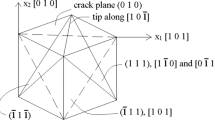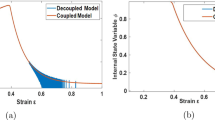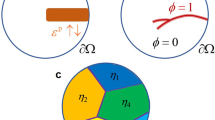Abstract
Ceramics polycrystals are subjected to slow crack growth (SCG) and also environmentally assisted failure, similarly to what is observed for glasses. The kinetics of fracture are known to be dependent on the load level, the temperature and also on the Relative Humidity (RH). However, evidences are available on the influence of the microstructure on the SCG rate with a marked increase in the resistance to the crack advance when comparing the response of a single crystal to that of a polycrystal. The clarification of the origin of the latter observation motivates the development of a local approach of fracture. We propose a physically based cohesive zone description that mimics the reaction-rupture process underlying SCG. We present how the parameters involved in the cohesive zone formulation can be determined to capture SCG in a single crystal. We then present simulations of intergranular failure in a 2D plane strain polycrystal. The triple junctions are shown to be key in the resistance to crack growth. The presence of defects at these junctions and their influence on the crack propagation is then investigated. We also show that the description is able to capture the damage induced by the process cooling, thus providing insight of the appropriate temperature for the sintering, for instance. The present numerical tool is then thought valuable to perform virtual tests on ceramics fracture in order to estimate thermal as well as mechanical loads limits for a safe use as well as proper the process conditions.
Similar content being viewed by others
References
Chevalier J, Olagnon C, Fantozzi G (1999) Subcritical crack propagation in 3Y-TZP ceramics: static and cyclic fatigue. J Am Ceram Soc 82(11): 3129–3138
Estevez R, Tijssens MGA, Giessen E (2000) Modelling the competition between shear yielding and crazing in glassy polymers. J Mech Phys Solids 48(12): 2585–2617
Michalske TA, Freiman SW (1983) A molecular mechanism for stress corrosion in vitreous silica. J Am Ceram Soc 66(4): 284–288
Olagnon C, Chevalier J, Pauchard V (2006) Global description of crack propagation in ceramics. J Eur Ceram Soc 26(15): 3051–3059
Ortiz M, Suresh S (1993) Statistical properties of residual stresses and intergranular fracture in ceramic materials. J Appl Mech 60: 77–84
Romero de la Osa M, Estevez R, Olagnon C, Chevalier J, Tallaron C, Vignoud L (2009) Modelling of environmentally assisted crack growth in ceramics. J Mech Adv Mater Struct (to be published)
Salem JA (2006) Slow crack growth and fracture toughness of sapphire for the international space station fluids and combustion facility. NASA/TM-2006-214023
Tijssens MGA, Giessen E, Sluys LJ (2000) Modelling crazing using a cohesive surface methodology. Mech Mater 32: 19–35
Tvergaard V, Hutchinson JW (1988) Microcracking in ceramics induced by thermal expansion or elastic anisotropy. J Am Ceram Soc 71(3): 157–166
Wan K, Lathabai S, Lawn B (1990) Crack velocity funcions and thresholds in brittle solids. J Am Ceram Soc 6: 259–268
Wiederhorn WE, Bolz LH (1970) Stress corrosion and static fatigue of glass. J Am Ceram Soc 53: 543–548
Zhu T, Li J, Lin X, Yip S (2005) Stress-dependent molecular pathways of silica-water reaction. J Mech Phys Solids 53: 1597–1623
Zhurkov SN (1965) Kinetic concept of the sterngth of solids. J Fract Mech 1: 311–323
Author information
Authors and Affiliations
Corresponding author
Rights and permissions
About this article
Cite this article
Romero de la Osa, M., Estevez, R., Olagnon, C. et al. Cohesive zone model and slow crack growth in ceramic polycrystals. Int J Fract 158, 157–167 (2009). https://doi.org/10.1007/s10704-009-9346-3
Received:
Accepted:
Published:
Issue Date:
DOI: https://doi.org/10.1007/s10704-009-9346-3




